Our recommendations are made independently. We may receive commissions from purchases made via our links.
How to Use a Charcoal Grill: Best User’s Guide to Charcoal Grills
While charcoal grills can make the juiciest, tastiest BBQs, they can be rather difficult to use. This guide will teach you how to use a charcoal grill.
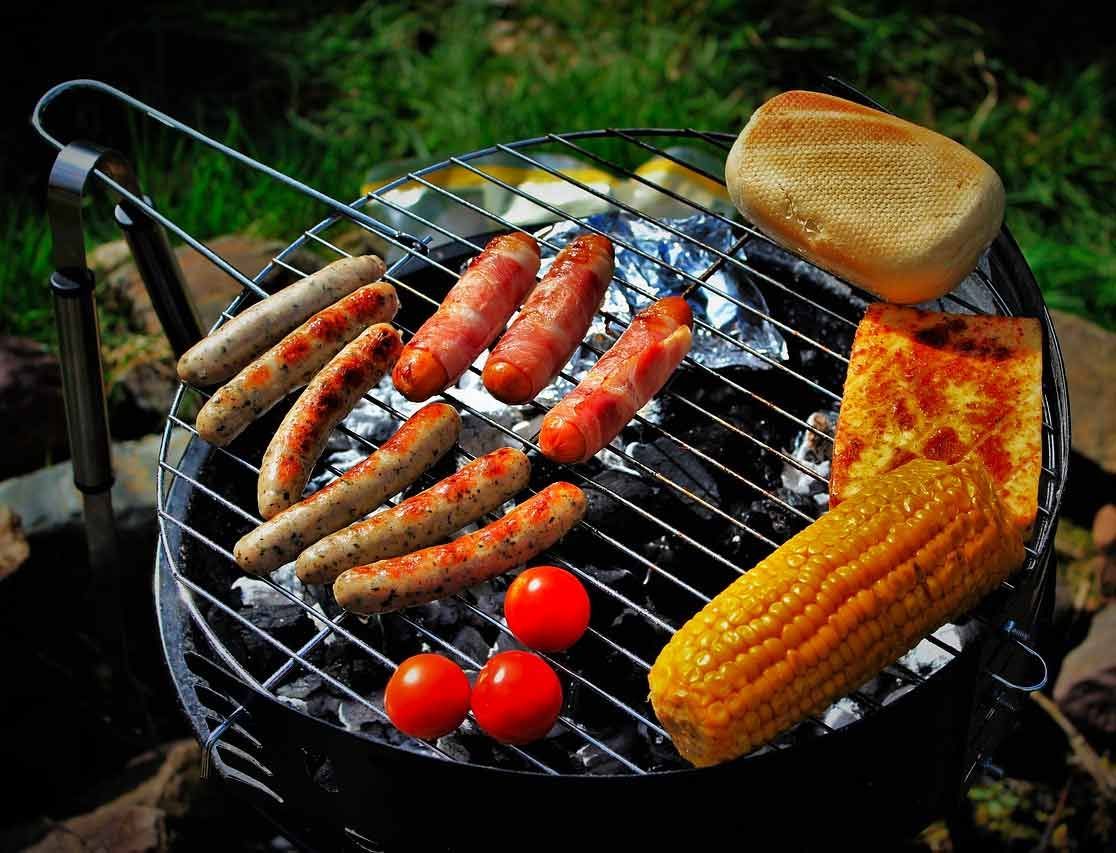
Traditional charcoal grills are still highly ranked among campers and outdoor cooks despite the wide availability of newer gas grills. Charcoal grills are more affordable, burn hotter, and thus can quicken the cooking process. But most importantly, only charcoal grills can authentically provide the smoky, char-grilled flavor highly coveted by foodies.
This article contains all you need to know about how to use a charcoal grill to get the perfect grill every single time.
Things to Know About Charcoal Grills
Lump Hardwood Charcoal vs. Briquettes vs. “Half-and-Half”
One of the most contentious issues among enthusiasts is whether it’s better to use lump (raw) hardwood charcoal or briquettes for cooking. Each type has their advantages and disadvantages that you ought to take into consideration before making your selection.
What Is Lump Hardwood Charcoal? Pros and Cons
Lump charcoal is produced by burning hardwood inside an oxygen-less chamber until all the moisture and sap in the wood evaporates.
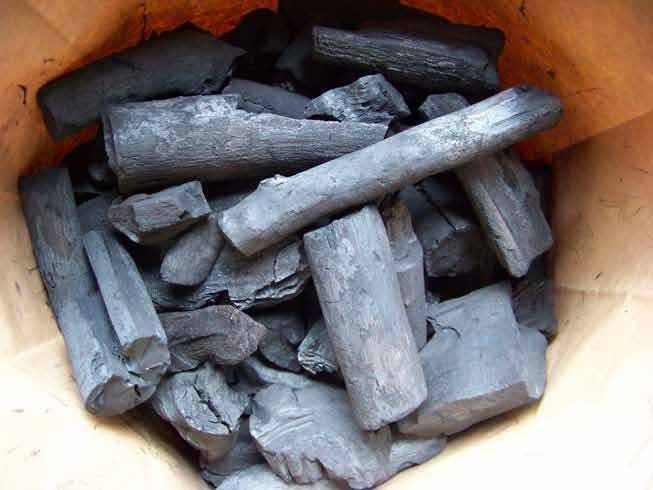
Compared to anthracite (hard coal) or black coal, charcoal is superior in a couple of ways. First, charcoal produces less ash while it’s burning. As a matter of fact, it produces even less ash than briquettes.
Heat-wise, although lump charcoal burns less hot than raw coal, it can produce way more heat than briquettes. As such, it’s the go-to fuel for high-heat cooking, allowing foods like steaks and burgers to develop a smoky crust without becoming overcooked.
Due to its high heat output, lump charcoal also has a reputation for burning out very quickly. If you decide to use this kind of fuel, you have to be extra cautious with temperature control. Fortunately, because charcoal is sensitive to oxygen, the heat output can be tamed pretty easily by adjusting the air vent.
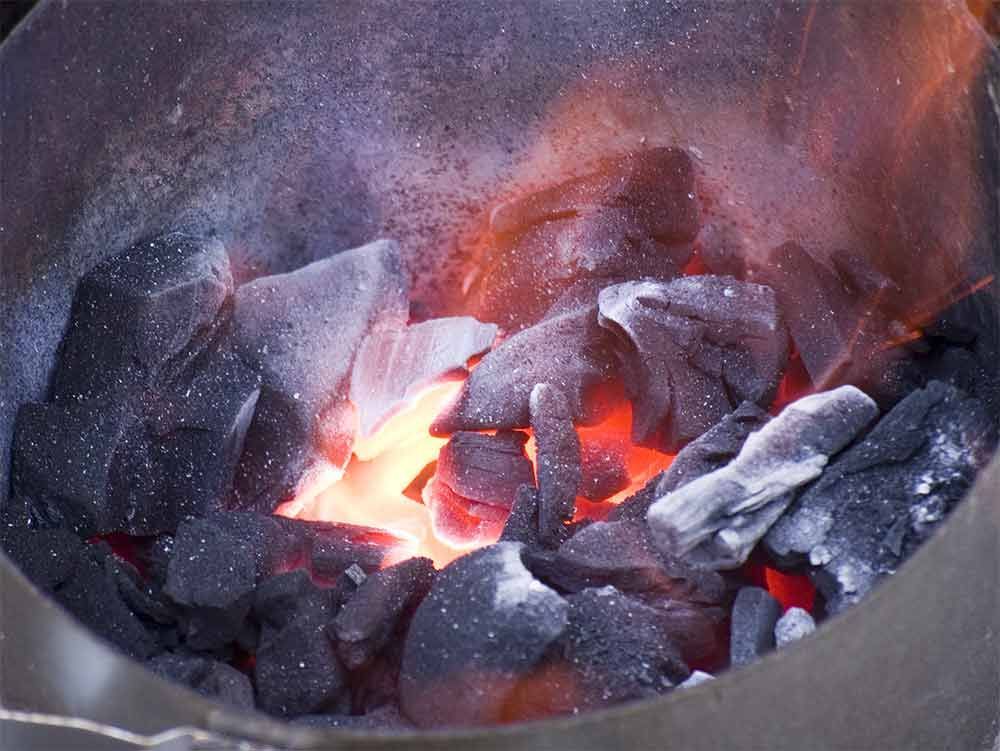
Lump charcoal is typically made with no additives, so it’s arguably the cleanest type of charcoal grill fuel available. Additives can make the food taste a little off rather than having the desired smoky flavor.
It’s not all good, however. Because charcoal is made from pure hardwood, it’s much more expensive per bag than briquettes. Furthermore, charcoal bags sometimes contain slabs that are too large to fit inside a grill. Then, you have to take the time and effort to break them into smaller-sized chunks before you can use them.
What Are Briquettes? Pros and Cons
Briquette (or “briquet”) is a type of refined, compressed fuel pellet. Unlike lump charcoal that’s only made from burnt hardwood, briquette can be made from a variety of materials. This can be sawdust, charcoal, coal dust, peat, or paper, among others.
Since briquettes are made from a mix-and-match of materials, additives are often included. The most common “extra ingredients” in briquettes are bonding agents. These help bind the materials together and allow them to be shaped into the compact, biscuit-sized bricks they’re known to be.
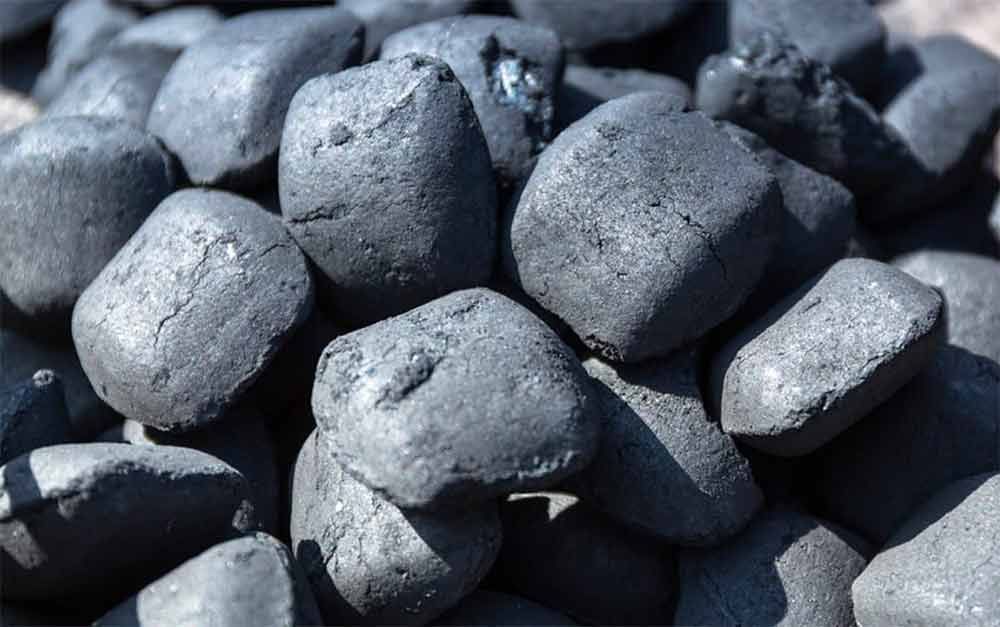
In a bid to make their briquettes easier to light, some brands add lighter fluid to the mix.
The addition of lighter fluid is one of the biggest reasons why many people are fervently against using briquettes for their meals. Lighter fluid has a unique smell that can impart a subtle, but noticeable “off” taste to the food. This, as expected, is unacceptable for a lot of people.
It’s not entirely bad to have lighter fluid in your briquettes, however. If you’re going hiking or camping, having lighter fluid-imbibed briquettes can save a significant amount of time and effort. Kindling a grill fire can be very difficult during wet, humid days. On those days, you’ll grow to appreciate the ease with which these briquettes catch fire.
But regardless of what you end up choosing, rest easy that the additives (including lighter fluid) in briquettes are generally safe for consumption. So far, there hasn’t been any evidence of briquette fumes being more harmful than charcoal. As a matter of fact, bio-briquettes (produced by mixing combustible materials with biomass) have notably lower emissions.
More importantly, while your food may taste strange, charcoal lighter fluid is mostly harmless. The only harm they could cause is due to their carbon monoxide and carbon dioxide emissions, both of which charcoal and briquettes emit as well. Lighter fluid will only be an issue if ingested.
Just to be safe, though, make sure you only source your lighter fluid-infused briquettes from reputable, trusted brands like Kingsford, Royal Oak, Weber, and Komodo. Or, if you’re anxious about it, just buy dry, non-infused briquettes.
What Are Half-and-Halfs? Pros and Cons
Many people like to mix both lump charcoals and briquettes together in their grill, resulting in a “half-and-half” fuel stack. By mixing them together, you get a combination of advantages and disadvantages from both fuel types.
There are many mixing techniques, but the most popular one is to build a “base layer” of briquettes and layer lump charcoals on top. The briquette base sustains the fire with its longer burn time, while the lump charcoal pieces— having a higher burn rate and temperature— heighten the heat. In addition, the top layer of lump charcoals also give your foods the desirable “smoky” taste.
The disadvantage is, since each fuel has a different burn rate, it’s harder to control the temperature.
Temperature Management
Arguably, the trickiest part to using a charcoal grill is maintaining the correct temperature. The grill component that will help you do this is the intake air damper.
The intake damper lets oxygen into the combustion chamber and nourishes the fire. If you throw the damper wide open (which allows for maximum airflow), temperature is going to be high. On the other hand, if you leave it open just by half or a quarter, the temperature is going to decrease accordingly.

Keep in mind that the more air you allow into the chamber, the hotter it’s going to get, and you’ll master the process in no time.
Aside from the intake air damper, you should also take note of the exhaust air damper. Its primary job is to vent the hot combustion gases back out into the environment.
But it also has a secondary job, which is helping the intake damper pull free oxygen into the grill. When hot gases rise through the exhaust damper, it creates an area of low pressure inside of the grill, which, in turn, pulls in cooler air from the environment.
Because of this, you should leave the exhaust damper fully opened at all times while you’re working the grill.
How Much Charcoal to Use?
The answer to this question depends on the type of food you’re cooking as well as the design of your grill. Because the right charcoal ratio is so varied, it’s next to impossible for us to provide exact numbers that would work for everyone.
Instead, you will have to figure this out yourself through trial and error.
Start by adding a conservative amount of coals into the grill and carefully adjust the temperature until you find a good burn rate. Most people will usually burn or undercook their food the first time. Don’t get discouraged, however; this is a common issue that even some veteran grillers still face.
How Long Does Charcoal Last?
Lump charcoal burns out quicker than briquettes. On average, depending on the temperature of the grill, you can get about 2 to 4 hours of burn time using lump charcoals. On the other hand, briquettes can last for as long as 4 to 5 hours. And, if you use half-and-half fuel, you’ll get around 3 to 4.5 hours.
The quality of the fuel used also affects burn time. Specifically, the more raw material there is in the fuel and the less chemical additives (binders, lighter fluid, etc.), the longer it can last.
How to Prepare a Charcoal Grill
Like managing temperature, starting a charcoal grill is a fairly complicated process. Fortunately, it shouldn’t take long.
Cleaning the Grill
Before you even attempt to start a charcoal fire, it’s crucial to clean your grilling set-up first. The grime and debris from past use can contaminate the food and make it unsafe for consumption.
Arranging the Coal
It is not advisable just to dump as much coal into the grill as possible, despite the fact it would simplify the process greatly. In order to get the best results, you have to learn how to arrange the coal correctly.
The trouble is, depending on the kind of cooking you’re about to undertake, there are many different arrangement styles you can do. Because of this, using a charcoal grill for the first time can be a puzzling experience.
One of the easiest arrangements to do is the “BBQ Pyramid.” Start with a large base and build up layers of briquettes or coals on the base, progressively getting smaller and smaller as the stack reaches higher.
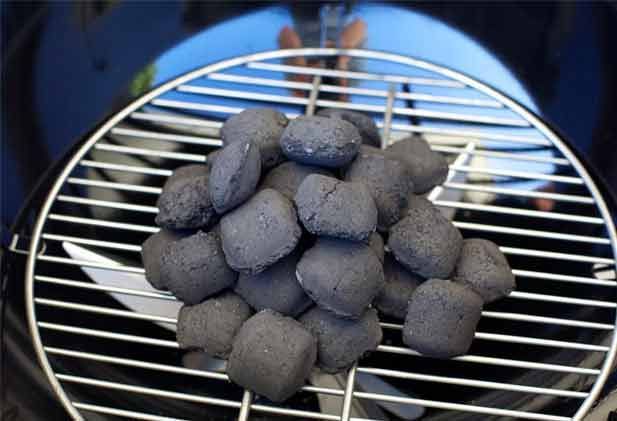
Albeit fairly simple to do, this is one of the most effective ways to get an even fire going. Another advantage to this method is that the heat generated is fairly mild and can be used to cook a wide variety of foods.
How to Start a Charcoal Grill
Once the preparations are finished, you have to consider which of the two common methods of starting a charcoal fire to use: either with lighter fluid or with a chimney.
Using Lighter Fluid
Other than burning fuels that have been dipped in lighter fluid in the factory, you should also learn how to burn dry fuel using a separate can of lighter fluid.
Pre-dipped Fuel
With this type of fuel, all you need is a classic grill lighter or a long match. Light the coals in several places to allow for an even burn. When the coals begin to turn white, the grill’s ready for use.
Separate Lighter Fluid
Exercise caution with this method, as mishandling lighter fluid can create serious fire hazards.
First, prepare and arrange your coal stack in the fashion you prefer. Next, evenly coat your fuel stack in a light layer of lighter fluid. Make sure you don’t use so much that the fluid pools at the bottom of the grill.
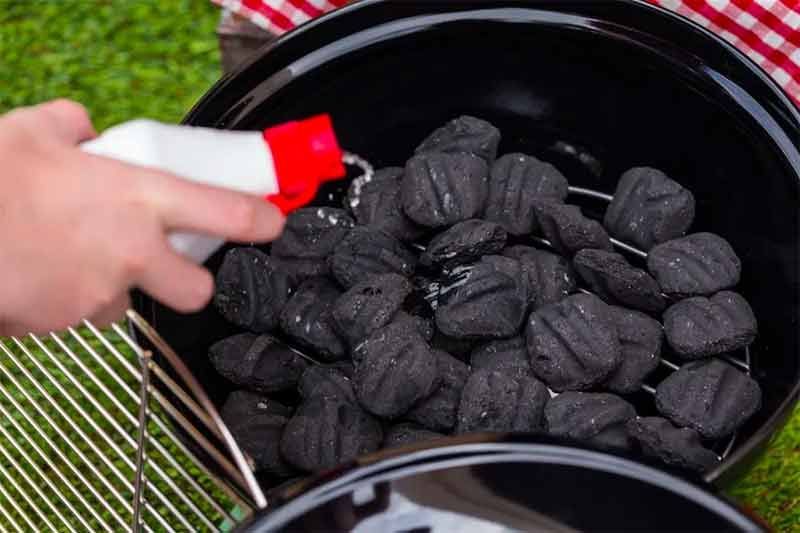
Once the fluid has been applied, allow it to sit and soak for about a minute or two.
A common rookie’s mistake is immediately lighting the coals once the fluid is poured. If you do, the fluid will burn off while the coals remain unignited, forcing you to add more fluid. This is not only a waste, but the chemical scents in your food will be stronger as well.
Once the coals have soaked up the fluid, you can use a specialized grill lighter or a long match to light the coal stack. Be very careful to light the stack evenly to ensure it has a consistent burn.
When the coals begin to turn white, it’s ready for use.
Using a Chimney Starter
Purists swear by chimney starters since they don’t give off annoying chemical fumes like lighter fluid. The “authentic” BBQ smell and taste are hard to pass up, too.
A chimney starter is quite simple in design and isn’t difficult to use. It’s a hollow metal canister with open compartments on either end to put the fire starter and the coals. They also come with a handle to make it easier to pour the burning coals into your grill.
They’re pretty easy to use. You only need to pour coals into the top compartment of the chimney. Then put a burning firestarter into the small compartment at the bottom. When the charcoal begins to burn bright, pick the chimney up by the handle and pour it into the grill.
If you want to delve deeper and learn other methods of starting the grill, use this detailed guide. It discusses in more details about each method. Additionally, the guide also includes a few methods to light the charcoal grill without using a chimney or lighter fluid, as well.
How to Grill with Charcoal
Before you start cooking, make sure you have an even, thick layer of lit coal underneath the grilling surface. A thin layer will result in low temperatures and a faster burnout.
When everything is checked and you’re ready to go, decide whether you want to grill using direct heat, indirect heat, or a mixture of both (two-zone fire).
Direct Heat Grilling
Direct heat means cooking right on top of the open flame where the heat is highest (typically between 450-550°F). This method is great for quick-cooking hot dogs, vegetables, and seafood. If you’re going to cook burgers or steaks, direct heat can give them attractive grill marks on the outer surface and amplify their colors.
Indirect Heat Grilling
Instead of cooking right on top of the flame, indirect heat grilling means cooking in areas adjacent to the flame where the heat is less intense (around 275-350°F). In practice, this can be done by using tongs to move the food away from the flame.
Use this technique when you have especially thick cuts of meat that need to sit for extended periods on the grill before they’re ready. The lower temperature will ensure you cook them evenly inside and out without drying or charring.
For advanced cooks, indirect grilling is the best way to introduce wood smoke into the meats and bring out their full flavor profile.
Two-Zone Fire
By creating a two-zone fire, you get the best of both worlds. It’s simple to build one: just put all of your coals to one half of the grill and leave the other side empty.

Place all of the foods that need to be seared or cooked in high heat on the side with the coals. Conversely, the empty side can serve as the place for low-temperature cooking or simmering. In case of flare-ups (a huge surge of flame when fat from the meat drips onto the coals), the empty side can also act as a safe zone.
How to Put out Charcoal Grill
Shutting down the Grill
First, put on a pair of flame-resistant oven mitts to protect yourself from potential burns.
Remove the rack, close the grill’s cover, and shut off all the vents. Ensure there’s no way for fresh air to enter the grill. When the flame has consumed all of the leftover oxygen, it will snuff itself out.
Beware that charcoal can take a long time to burn out; it could take as much as 24 to 48 hours before the coal fire is smothered. Therefore, when the cover, vents, and everything else are closed off, you should leave the grill for a day or two.
Unless you’re absolutely sure the fire has gone out, do not open the cover or the vents. Doing so will reintroduce air to the chamber and, if the fire is still active, it will reignite.
Remove and Dispose of the Fuel
Once the grill has cooled down, use a pair of tongs to transfer the remaining pieces of coals or briquettes onto a piece of aluminium foil. If any of the leftover fuel is still hot, the foil will make sure it doesn’t set anything in the trash can alight and create a literal dumpster fire.
Avoid dumping the fuel into a plastic trash can. If you have metal trash cans around, use those. If a dumpster fire occurs, a metal trash can is better equipped to deal with the resulting heat. Meanwhile, a plastic can will just melt and create a bigger problem.
Do Not Use Water
As tempting as it is to just douse the flame with cold water, it is inadvisable to do so.
The high heat of the fuel combined with the cool temperature of the water can create heat shocks and crack your grill. Furthermore, steam and ash will shoot everywhere when water meets the hot coals and could cause serious injuries if you’re not careful.
Conclusion
Charcoal grilling is an excellent way to enjoy a nice day outdoors with friends and family. We hope this guide has given you a better idea of how to use your new-fangled charcoal grill. Though it definitely will take some practice before you become fluent, the final, tasty results will be well worth the hassle!





